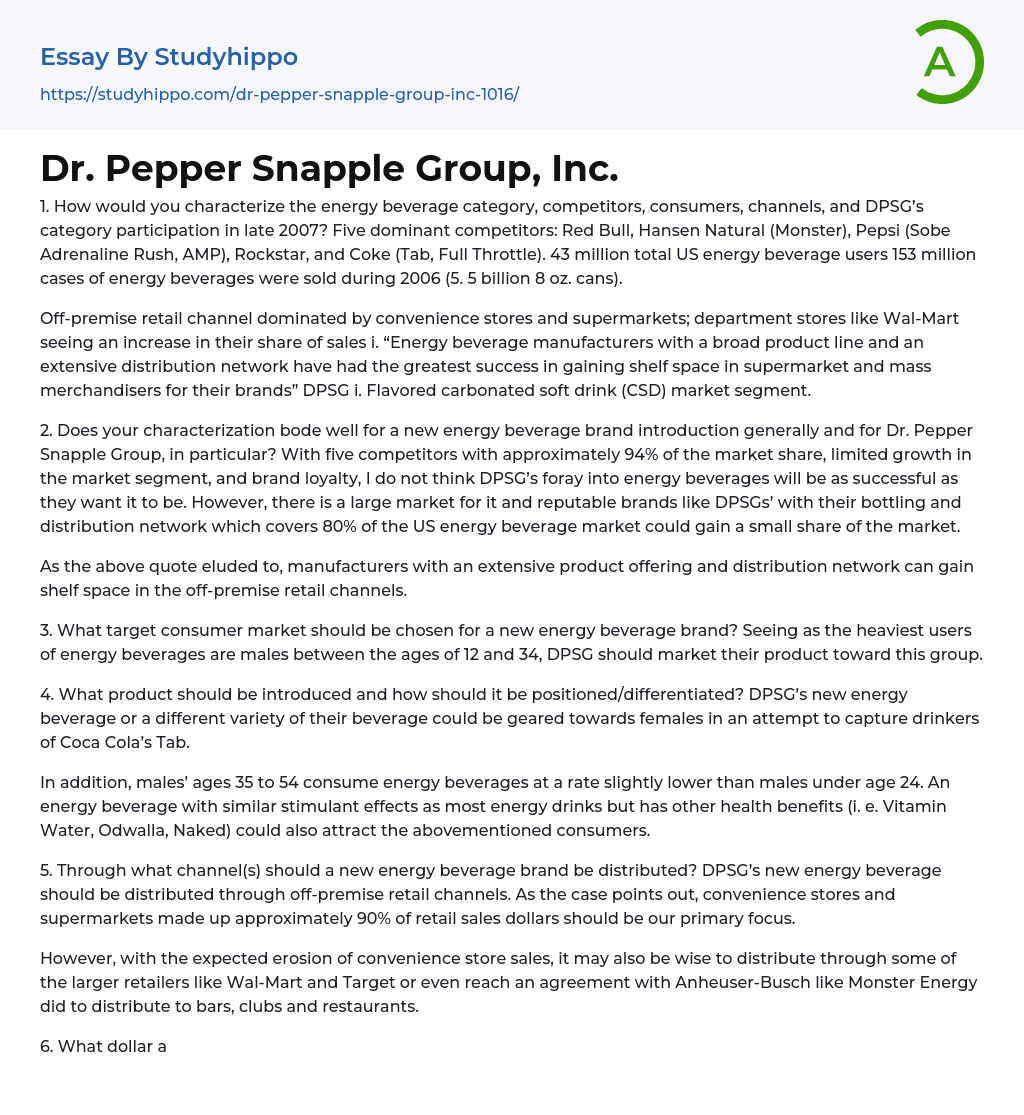1. How would you characterize the energy beverage category, competitors, consumers, channels, and DPSG’s category participation in late 2007? Five dominant competitors: Red Bull, Hansen Natural (Monster), Pepsi (Sobe Adrenaline Rush, AMP), Rockstar, and Coke (Tab, Full Throttle). 43 million total US energy beverage users 153 million cases of energy beverages were sold during 2006 (5. 5 billion 8 oz. cans).
Off-premise retail channel dominated by convenience stores and supermarkets; department stores like Wal-Mart seeing an increase in their share of sales i. “Energy beverage manufacturers with a broad product line and an extensive distribution network have had the greatest success in gaining shelf space in supermarket and mass merchandisers for their brands” DPSG i. Flavored carbonated soft drink (CSD) market segment.
2. Does your characterization bode well for a new ener
...gy beverage brand introduction generally and for Dr. Pepper Snapple Group, in particular? With five competitors with approximately 94% of the market share, limited growth in the market segment, and brand loyalty, I do not think DPSG’s foray into energy beverages will be as successful as they want it to be. However, there is a large market for it and reputable brands like DPSGs’ with their bottling and distribution network which covers 80% of the US energy beverage market could gain a small share of the market.
As the above quote eluded to, manufacturers with an extensive product offering and distribution network can gain shelf space in the off-premise retail channels.
3. What target consumer market should be chosen for a new energy beverage brand? Seeing as the heaviest users of energy beverages are males between the ages of 12 and 34, DPSG should market their product towar
this group.
4. What product should be introduced and how should it be positioned/differentiated? DPSG’s new energy beverage or a different variety of their beverage could be geared towards females in an attempt to capture drinkers of Coca Cola’s Tab.
In addition, males’ ages 35 to 54 consume energy beverages at a rate slightly lower than males under age 24. An energy beverage with similar stimulant effects as most energy drinks but has other health benefits (i. e. Vitamin Water, Odwalla, Naked) could also attract the abovementioned consumers.
5. Through what channel(s) should a new energy beverage brand be distributed? DPSG’s new energy beverage should be distributed through off-premise retail channels. As the case points out, convenience stores and supermarkets made up approximately 90% of retail sales dollars should be our primary focus.
However, with the expected erosion of convenience store sales, it may also be wise to distribute through some of the larger retailers like Wal-Mart and Target or even reach an agreement with Anheuser-Busch like Monster Energy did to distribute to bars, clubs and restaurants.
6. What dollar amount for media advertising and promotion should be budged for a new energy beverage brand? As the case mentioned, the top five competitors spent approximately $70 million measured advertising media. In DPSG’s case, it would probably be a good idea to invest $20 million for advertising and promotions.
DPSG does not have the breadth and reach of Red Bull in regards to energy beverages and advertising but to break into the market and remain competitive with Red Bull, they may even need to invest more into their marketing strategies (ex. Social network sites, YouTube, sponsoring sporting events, taste testing at grocery
stores, malls, and other events).
7. What suggested retail price should be recommended for a new beverage brand? DPSG should sell their energy beverage at a retail price of $1. 89 per single serve package. This would place their product below the $1. 99 to $2. 49 range for most popular energy drinks. In addition, the lower price may provide incentive for loyal customers to try something new.
- Wal-Mart essays
- Discover essays
- Advertisement essays
- Advertising essays
- Anheuser-busch essays
- Audience Theory essays
- Brand essays
- Brands essays
- Competitor Analysis essays
- Consumer essays
- Detergent essays
- Marketing Management essays
- Marketing Mix essays
- Marketing Plan essays
- Marketing Research essays
- Marketing Strategy essays
- New Product Development essays
- Point Of Sale essays
- Price essays
- Procurement essays
- Product essays
- Product Differentiation essays
- Product Placement essays
- Promotion essays
- Promotion And Marketing Communications essays
- Research Design essays
- Retailing essays
- Trademark essays
- Adidas essays
- Amazon essays
- Apple essays
- Bmw essays
- British Airways essays
- Burger King essays
- Coca-Cola essays
- Company essays
- Costco essays
- Dell essays
- Ebay essays
- Enron essays
- Facebook essays
- Ford Motor Company essays
- Gap essays
- General Motors essays
- Google essays
- Honda essays
- Ibm essays
- Ikea essays
- Intel essays
- Iphone essays




